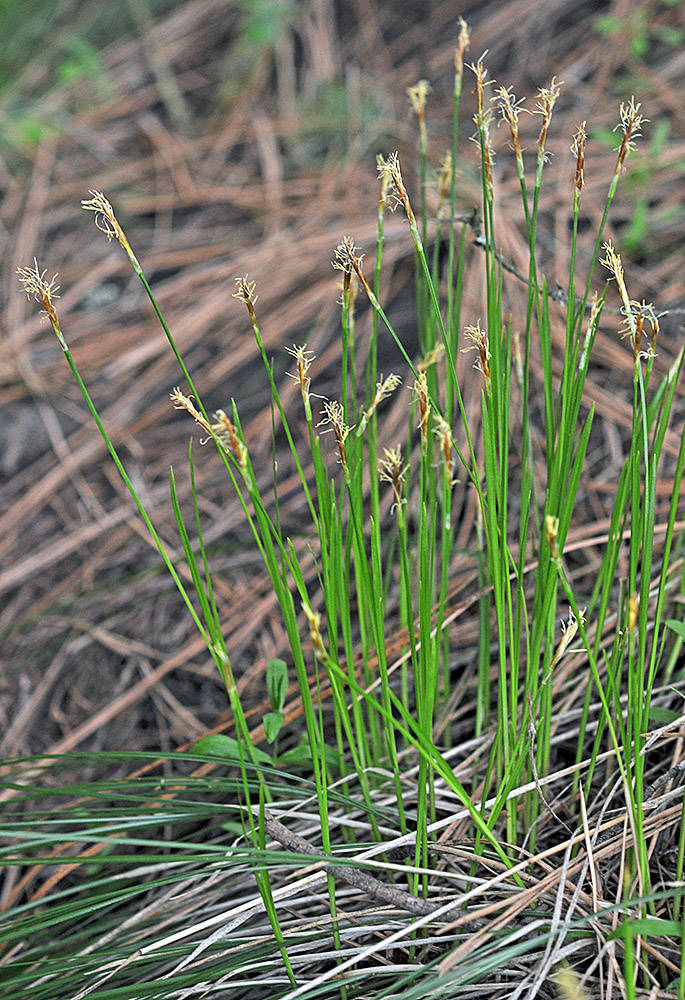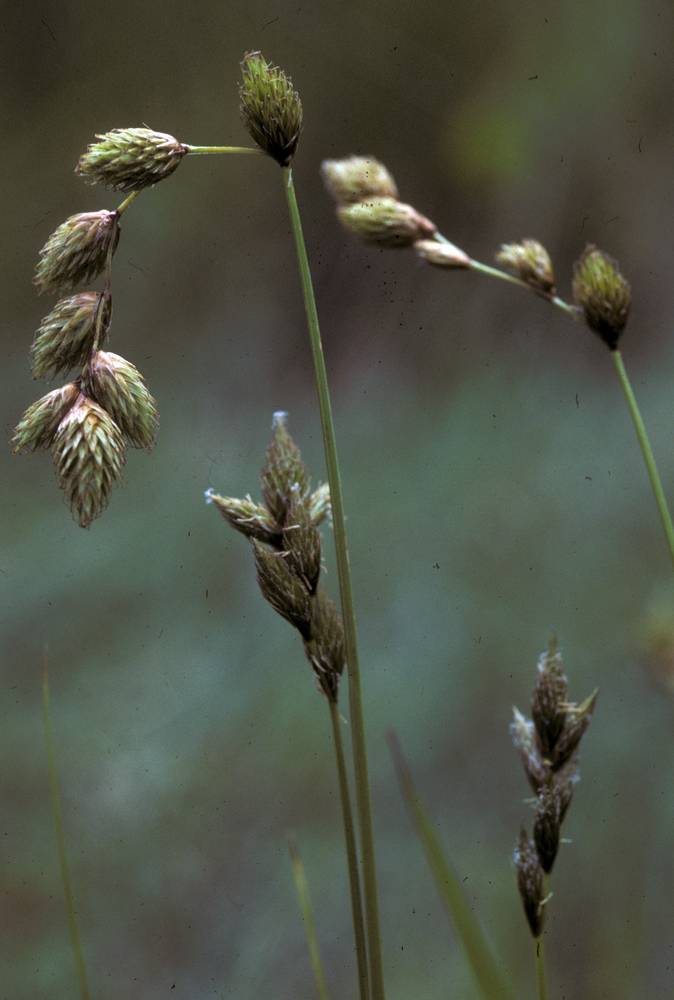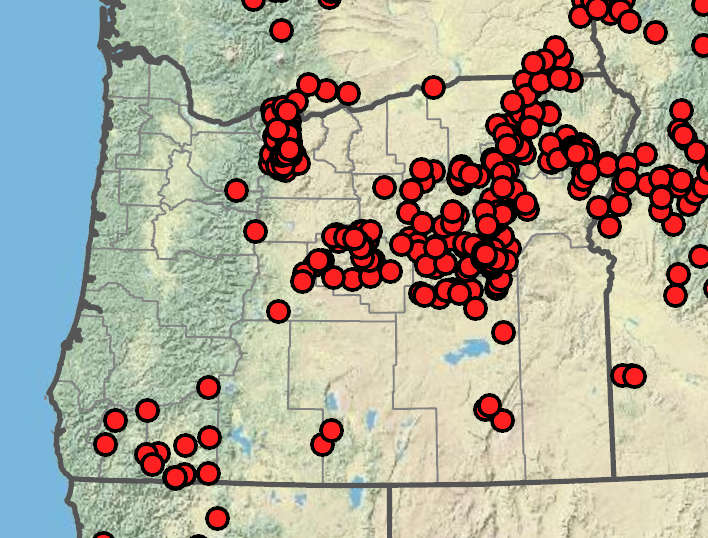|
elk sedge
|
eggbract sedge, hare sedge, oval broom sedge, oval sedge
|
| Plants loosely cespitose or short rhizomatous, with thick, dark, shallow rhizomes; culms 12–50 cm, triangular in cross section. |
Plants cespitose, (24)35–85 cm tall at flowering; vegetative shoots elongating late in the season and becoming stolons (developing shoots and roots at the nodes), sprawling over shorter vegetation. |
1.1–3.5 mm wide; flat; evergreen; leathery; as long as or longer than the culms. |
(1.5)2– 3.5(4) mm wide. |
spike solitary, androgynous, lacking inflorescence bracts; male terminal portion 1–2.5 cm long, separated from the 1–3 perigynia by a short internode. |
1.5–4 cm × 10–15 mm; erect to flexuous, not head-like; the lower spikes somewhat separated; spikes gynaecandrous. |
obovate, rounded at the top, 5–7(8.5) × 1.8–2.8 mm, green; whitish, or brown; beak small; stigmas 3. |
3.4–4.7(5.2) × 1.3–2.1 mm; straw-colored or light brown, with 3–9 conspicuous dorsal veins and 2–5 conspicuous ventral veins; wings 0.2–0.5 mm wide; beak brown; parallel-sided; entire for the distal 0.3–0.5 mm (occasionally winged almost to the tip); (1.2)1.5–2 mm from achene top to beak tip; stigmas 2. |
trigonous. |
lenticular, 1.1–1.8 × 0.9–1.2 mm, 0.4–0.5 mm thick. |
the lower longer than the perigynia; the upper reduced; more or less brown with paler midrib and margins, pointed to awned. |
3.4–5 mm long; longer or shorter; wider or narrower than the perigynia; straw-colored, brown or green; margins not white-hyaline; the tip often white-hyaline; acute to acuminate. |
|
=62, 64, 66, 68. |
|
|
|
|
|
|
|
Well-drained soils in dry, open, conifer forests, aspen stands, and openings, rarely in sagebrush, on both serpentine and nonserpentine substrates. 100–2500 m. BR, BW, Col, ECas, Lava, Owy, Sisk. CA, ID, NV, WA; north to southeastern British Columbia, east to CO, PA. Native. Carex geyeri is a common ground cover in open forest, especially in northeastern Oregon, recognized by its tough, flat, evergreen leaves from dark, scaly rhizomes. Similar pinegrass, Calamagrostis rubescens, usually has hairy internodes and when in flower it is easily distinguished. Carex geyeri is important food for wildlife and livestock, especially in winter. In southwestern Oregon, C. geyeri can be confused with C. multicaulis, which is densely cespitose and has proportionately shorter, usually involute leaves, and longer, green, leaf-like, lower female scales. |
Moist meadows and wet prairies at low elevations. 50–1400 m. CR, Sisk, WV. CA, NV, WA; north to British Columbia, WI to Prince Edward Island south to KY and NC; Australia, Eurasia, New Zealand. Native. Carex leporina is a loosely tufted sedge with a light brown, somewhat elongate inflorescence. The stolons form late in the season and are rarely collected. Similar C. praticola has female scales with white margins. Its perigynia are veinless or weakly veined on the ventral surface, have longer beaks that are brown, parallel-sided, and wingless for the distal 0.4–1 mm and have the very tip narrowly white-edged. |
Flora of Oregon, volume 1, page 202
Barbara Wilson, Richard Brainerd, Nick Otting |
Flora of Oregon, volume 1, page 210
Barbara Wilson, Richard Brainerd, Nick Otting |
C. abrupta, C. agastachys, C. amplifolia, C. angustata, C. aperta, C. aquatilis, C. arcta, C. arenaria, C. atherodes, C. athrostachya, C. atrosquama, C. aurea, C. barbarae, C. bebbii, C. bolanderi, C. brainerdii, C. brevior, C. breweri, C. buchananii, C. buxbaumii, C. californica, C. canescens, C. capillaris, C. capitata, C. chordorrhiza, C. comans, C. comosa, C. concinna, C. concinnoides, C. cordillerana, C. crawfordii, C. cusickii, C. davyi, C. deflexa, C. densa, C. diandra, C. disperma, C. distans, C. douglasii, C. duriuscula, C. echinata, C. exsiccata, C. feta, C. filifolia, C. fissuricola, C. fracta, C. gynocrates, C. gynodynama, C. halliana, C. harfordii, C. hassei, C. haydeniana, C. hendersonii, C. heteroneura, C. hirsutella, C. hirta, C. hoodii, C. hystericina, C. idahoa, C. illota, C. infirminervia, C. inops, C. integra, C. interior, C. interrupta, C. jonesii, C. kelloggii, C. klamathensis, C. kobomugi, C. laeviculmis, C. lasiocarpa, C. leporina, C. leporinella, C. leptalea, C. leptopoda, C. limosa, C. livida, C. longii, C. luzulina, C. lyngbyei, C. macrocephala, C. macrochaeta, C. media, C. mendocinensis, C. mertensii, C. mesochorea, C. micropoda, C. microptera, C. multicaulis, C. nardina, C. nebrascensis, C. nervina, C. neurophora, C. nigricans, C. nudata, C. obnupta, C. pachycarpa, C. pachystachya, C. pansa, C. paysonis, C. pellita, C. pelocarpa, C. pendula, C. petasata, C. phaeocephala, C. pluriflora, C. praeceptorum, C. praegracilis, C. praticola, C. preslii, C. pumila, C. raynoldsii, C. retrorsa, C. rossii, C. saxatilis, C. scabriuscula, C. scirpoidea, C. scoparia, C. scopulorum, C. serpenticola, C. serratodens, C. sheldonii, C. simulata, C. spectabilis, C. stipata, C. straminiformis, C. subbracteata, C. subfusca, C. subnigricans, C. sychnocephala, C. tahoensis, C. tiogana, C. tribuloides, C. tumulicola, C. unilateralis, C. utriculata, C. vallicola, C. vernacula, C. vesicaria, C. viridula, C. vulpinoidea, C. whitneyi, C. zikae |
C. abrupta, C. agastachys, C. amplifolia, C. angustata, C. aperta, C. aquatilis, C. arcta, C. arenaria, C. atherodes, C. athrostachya, C. atrosquama, C. aurea, C. barbarae, C. bebbii, C. bolanderi, C. brainerdii, C. brevior, C. breweri, C. buchananii, C. buxbaumii, C. californica, C. canescens, C. capillaris, C. capitata, C. chordorrhiza, C. comans, C. comosa, C. concinna, C. concinnoides, C. cordillerana, C. crawfordii, C. cusickii, C. davyi, C. deflexa, C. densa, C. diandra, C. disperma, C. distans, C. douglasii, C. duriuscula, C. echinata, C. exsiccata, C. feta, C. filifolia, C. fissuricola, C. fracta, C. geyeri, C. gynocrates, C. gynodynama, C. halliana, C. harfordii, C. hassei, C. haydeniana, C. hendersonii, C. heteroneura, C. hirsutella, C. hirta, C. hoodii, C. hystericina, C. idahoa, C. illota, C. infirminervia, C. inops, C. integra, C. interior, C. interrupta, C. jonesii, C. kelloggii, C. klamathensis, C. kobomugi, C. laeviculmis, C. lasiocarpa, C. leporina, C. leporinella, C. leptalea, C. leptopoda, C. limosa, C. livida, C. longii, C. luzulina, C. lyngbyei, C. macrocephala, C. macrochaeta, C. media, C. mendocinensis, C. mertensii, C. mesochorea, C. micropoda, C. microptera, C. multicaulis, C. nardina, C. nebrascensis, C. nervina, C. neurophora, C. nigricans, C. nudata, C. obnupta, C. pachycarpa, C. pachystachya, C. pansa, C. paysonis, C. pellita, C. pelocarpa, C. pendula, C. petasata, C. phaeocephala, C. pluriflora, C. praeceptorum, C. praegracilis, C. praticola, C. preslii, C. pumila, C. raynoldsii, C. retrorsa, C. rossii, C. saxatilis, C. scabriuscula, C. scirpoidea, C. scoparia, C. scopulorum, C. serpenticola, C. serratodens, C. sheldonii, C. simulata, C. spectabilis, C. stipata, C. straminiformis, C. subbracteata, C. subfusca, C. subnigricans, C. sychnocephala, C. tahoensis, C. tiogana, C. tribuloides, C. tumulicola, C. unilateralis, C. utriculata, C. vallicola, C. vernacula, C. vesicaria, C. viridula, C. vulpinoidea, C. whitneyi, C. zikae |
|
Carex ovalis, Carex tracyi |
| |
BC,
CA,
OR,
WA
CalFlora,
CalPhotos,
Flora NW,
PNW Herbaria
WildflowerSearch
iNaturalist (observations)
USDA Plants Database
BC,
CA,
OR,
WA
CalFlora,
CalPhotos,
Flora NW,
PNW Herbaria
WildflowerSearch
iNaturalist (observations)
USDA Plants Database





